Tsoulfanidis N. Measurement and detection of radiation
Подождите немного. Документ загружается.

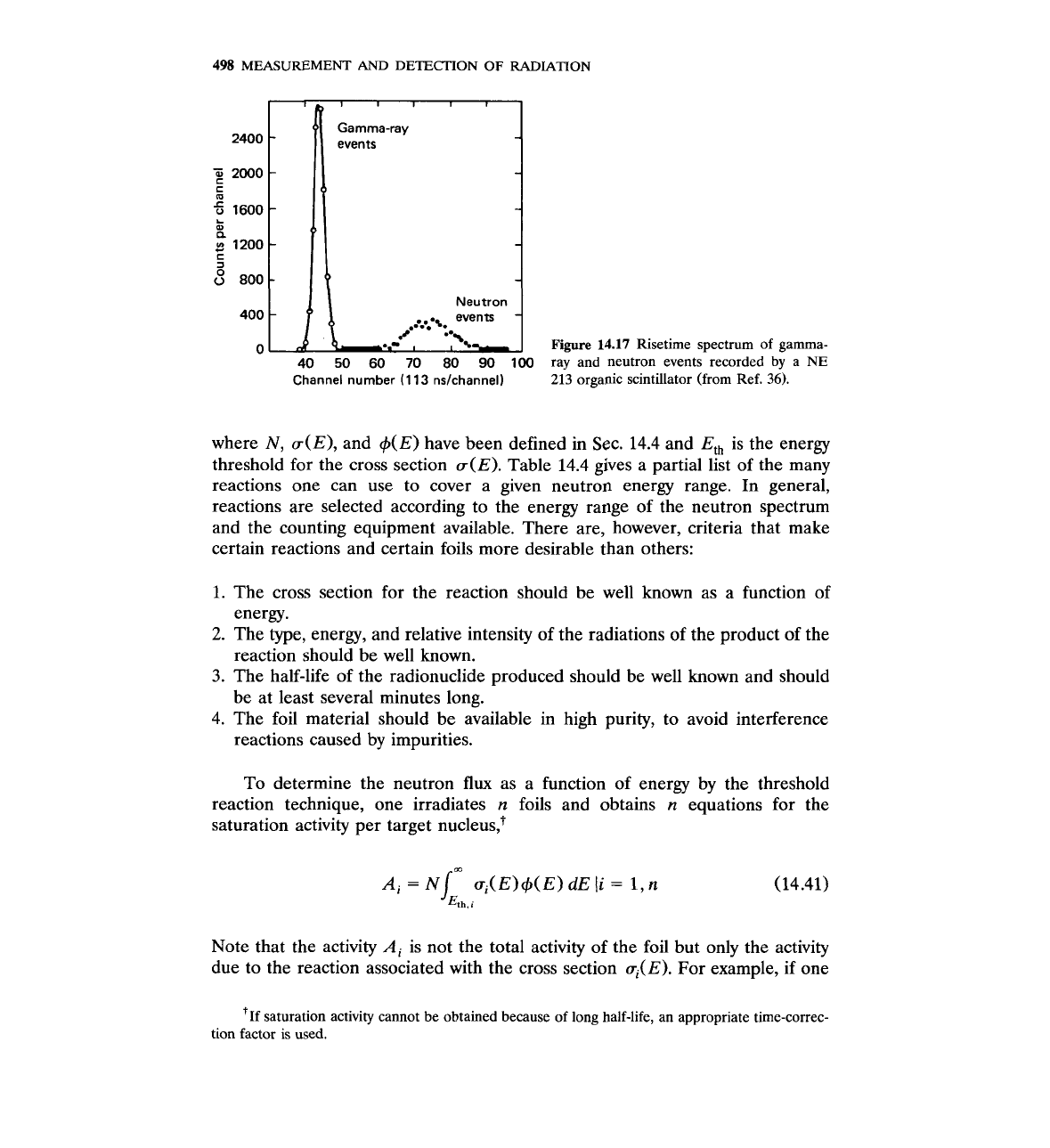
498
MEASUREMENT
AND DETECTION OF RADIATION
lb
I
I
1
1 1
0
Gamma-ray
2400
-
-
events
2000
-
-
c
18
m
5
1600
-
-
L
m
a
I
g
1200
-
-
c
3
s
800
-
I
-
Neutron
400
-
"
..-.":.yn"
-
0
.*-
,
I
40 50 60 70 80 90 100
Channel number
(1
13 nslchannel)
Figure
14.17
Risetime spectrum of gamma-
ray and neutron events recorded
by
a
NE
213
organic scintillator (from Ref.
36).
where N, cr(E), and +(E) have been defined in Sec. 14.4 and Eth is the energy
threshold for the cross section cr(E). Table 14.4 gives a partial list of the many
reactions one can use to cover a given neutron energy range. In general,
reactions are selected according to the energy range of the neutron spectrum
and the counting equipment available. There are, however, criteria that make
certain reactions and certain foils more desirable than others:
1. The cross section for the reaction should be well known as a function of
energy.
2.
The type, energy, and relative intensity of the radiations of the product of the
reaction should be well known.
3.
The half-life of the radionuclide produced should be well known and should
be at least several minutes long.
4. The foil material should be available in high purity, to avoid interference
reactions caused by impurities.
To determine the neutron
flux
as a function of energy by the threshold
reaction technique, one irradiates
n
foils and obtains
n
equations for the
saturation activity per target nucleus,+
Note that the activity
Ai
is not the total activity of the foil but only the activity
due to the reaction associated with the cross section ui(E). For example, if one
'1f saturation activity cannot be obtained because of long half-life, an appropriate time-correc-
tion factor is used.
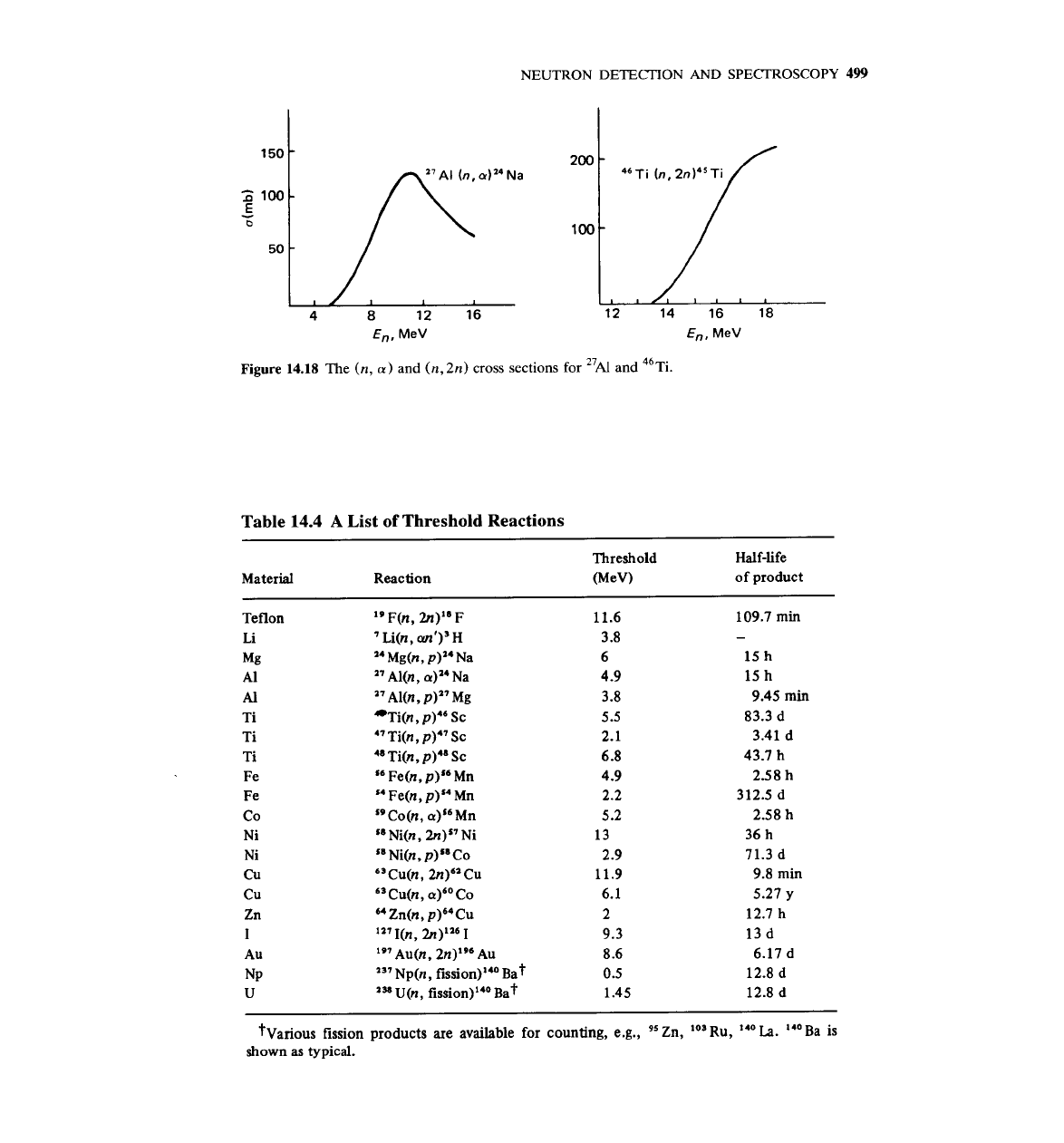
NEUTRON DETECTION
AND
SPECTROSCOPY
499
En,
MeV
En,
MeV
Figure
14.18
The
(n,
a)
and
(n, 2n)
cross sections for
"AI
and
46~i.
Table 14.4
A
List
of Threshold Reactions
Threshold Half-life
Material Reaction (MeV) of product
Teflon
l9
F(n, 2n)18 F
11.6 109.7
min
Li 'Li(n, WZ')~H
3.8
-
Mg
"
Mg(n, p)" Na
6 15 h
A1
"
Al(n
,
a)'4 Na
4.9 15h
A1
"
Al(n, p)" Mg
3.8 9.45
min
Ti
Ti@, P)'~ SC
5.5 83.3
d
Ti
4'
Ti(n
,
p)47 SC
2.1 3.41
d
Ti
48
Ti@, p)48 Sc
6.8 43.7 h
Fe
s6
Fe(n, P)'~ Mn
4.9 2.58
h
Fe
s4
Fe(n, Mn
2.2 312.5
d
Co "Co(n, a)s6 Mn
5.2 2.58 h
Ni Ni(n
,
2n)
"
Ni
13 36 h
Ni
"
Ni(n, p)"Co
2.9 71.3
d
Cu
"
Cu(n, 2n)6' Cu
11.9 9.8
min
Cu 63Cu(n, a)60 Co
6.1 5.27
y
Zn
64
Zn(n, p)64 Cu
2 12.7
h
I
la'
I(n, 2n)la6 I
9.3 13
d
Au
19'
Au(n, 2n)lP6 Au
8.6 6.17
d
NP Np(n, fission)140
at
0.5 12.8
d
U
U(n, fis~ion)"~
at
1.45 12.8
d
?various fission products are available for counting, e.g.,
95
Zn,
lo3
Ru,
140
La.
"O
Ba is
shown
as
typical.
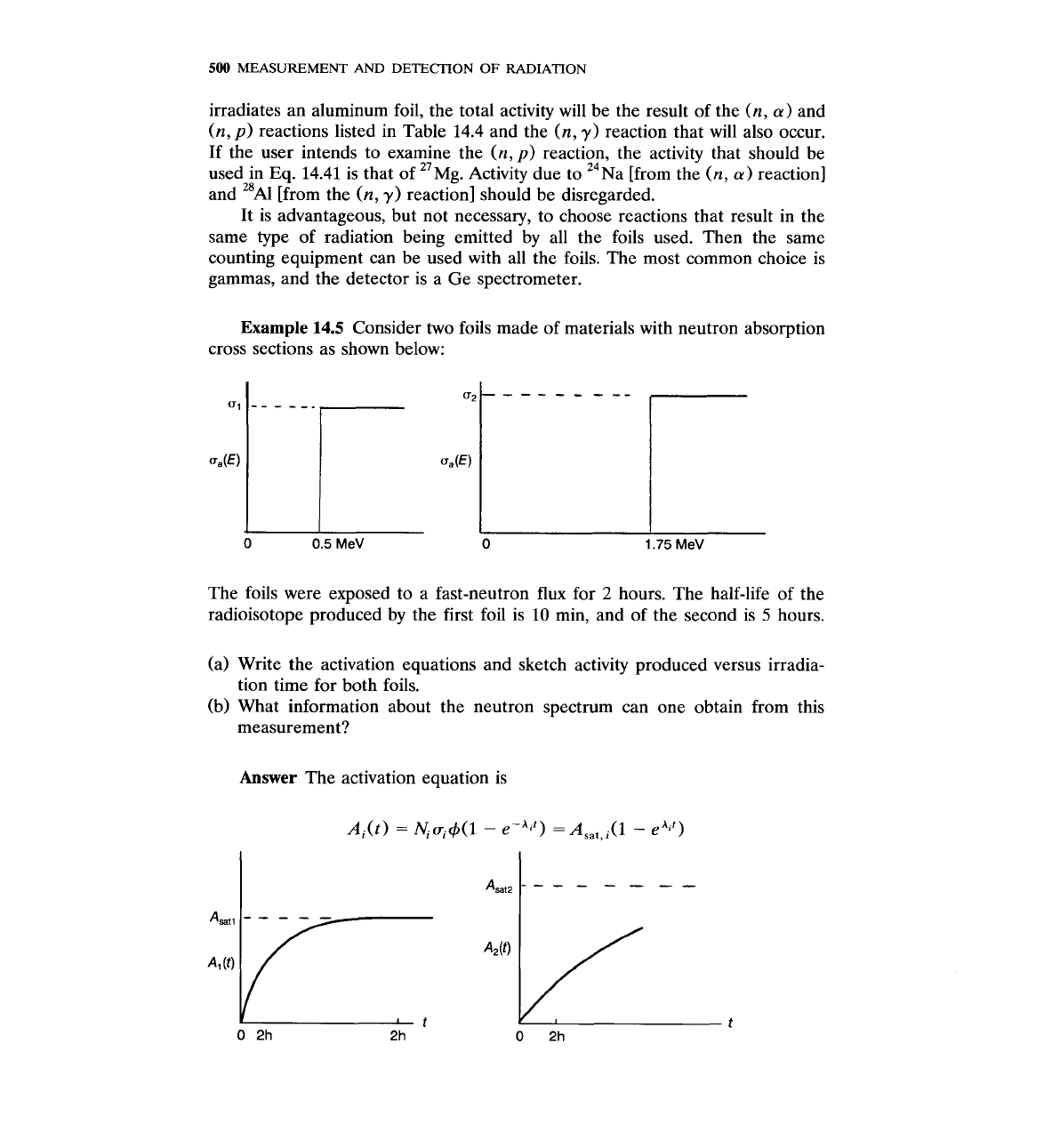
500
MEASUREMENT
AND
DETECTION OF
RADIATION
irradiates an aluminum foil, the total activity will be the result of the (n, a) and
(n,
p)
reactions listed in Table 14.4 and the
(n,
-y) reaction that will also occur.
If the user intends to examine the (n,
p)
reaction, the activity that should be
used in
Eq.
14.41 is that of
27~g.
Activity due to 24~a [from the (n, a) reaction]
and
28Al
[from the (n, y) reaction] should be disregarded.
It is advantageous, but not necessary, to choose reactions that result in the
same type of radiation being emitted by all the foils used. Then the same
counting equipment can be used with all the foils. The most common choice is
gammas, and the detector is a Ge spectrometer.
Example
14.5
Consider two foils made of materials with neutron absorption
cross sections as shown below:
The foils were exposed to a fast-neutron
flux
for
2
hours. The half-life of the
radioisotope produced by the first foil is 10 min, and of the second is
5
hours.
(a) Write the activation equations and sketch activity produced versus irradia-
tion time for both foils.
(b) What information about the neutron spectrum can one obtain from this
measurement?
Answer
The activation equation is
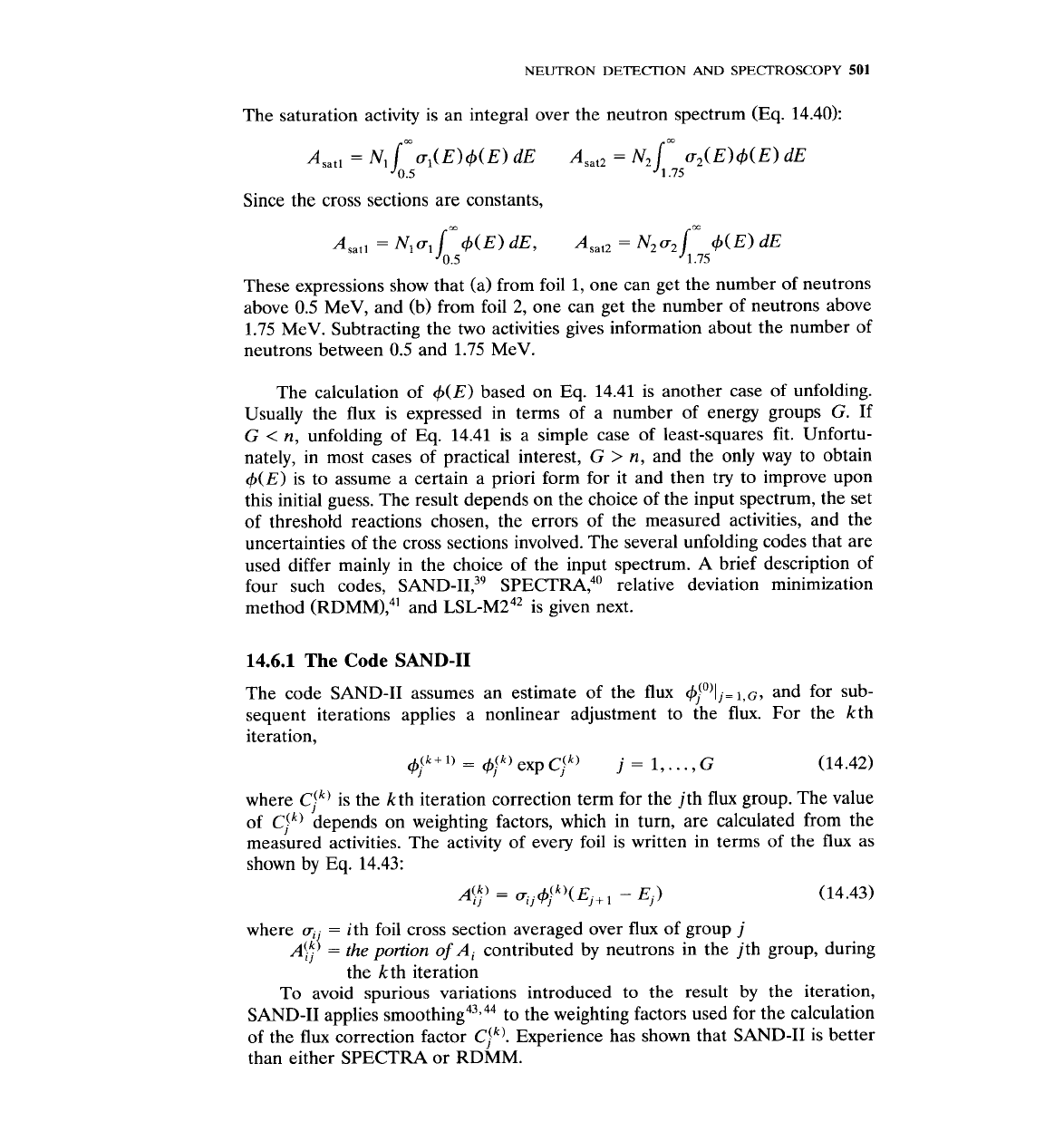
NEUTRON
DETECTION
AND
SPECTROSCOPY
501
The saturation activity is an integral over the neutron spectrum (Eq. 14.40):
Since the cross sections are constants,
These expressions show that (a) from foil 1, one can get the number of neutrons
above 0.5 MeV, and (b) from foil 2, one can get the number of neutrons above
1.75 MeV. Subtracting the two activities gives information about the number of
neutrons between 0.5 and 1.75 MeV.
The calculation of +(E) based on Eq. 14.41 is another case of unfolding.
Usually the
flux
is expressed in terms of a number of energy groups
G.
If
G
<
n, unfolding of Eq. 14.41 is a simple case of least-squares fit. Unfortu-
nately, in most cases of practical interest,
G
>
n, and the only way to obtain
4(E) is to assume a certain a priori form for it and then try to improve upon
this initial guess. The result depends on the choice of the input spectrum, the set
of threshold reactions chosen, the errors of the measured activities, and the
uncertainties of the cross sections involved. The several unfolding codes that are
used differ mainly in the choice of the input spectrum.
A
brief description of
four such codes, SAND-II?~ SPECTRA,"' relative deviation minimization
method (RDMM)?' and LSL-M242 is given next.
14.6.1
The
Code
SAND-I1
The code SAND-I1 assumes an estimate of the
flux
#")I,=I,G, and for sub-
sequent iterations applies a nonlinear adjustment to the flux. For the kth
iteration,
4jk+l)
=
4jk)
exp~j(k)
j
=
1,
...,G
(14.42)
where
cjk)
is the kth iteration correction term for the jth
flux
group. The value
of
cjk)
depends on weighting factors, which in turn, are calculated from the
measured activities. The activity of every foil is written in terms of the
flux
as
shown by
Eq.
14.43:
A$'
=
g.
.~W(E,+,
-
E,)
'I I
(14.43)
where
a,
-
=
ith foil cross section averaged over flux of group
j
~!fj
=
the
portion of Ai contributed by neutrons in the jth group, during
the kth iteration
To avoid spurious variations introduced to the result by the iteration,
SAND-I1 applies ~moothin~~~,~~ to the weighting factors used for the calculation
of the
flux
correction factor
cjk).
Experience has shown that SAND-I1 is better
than either SPECTRA or RDMM.
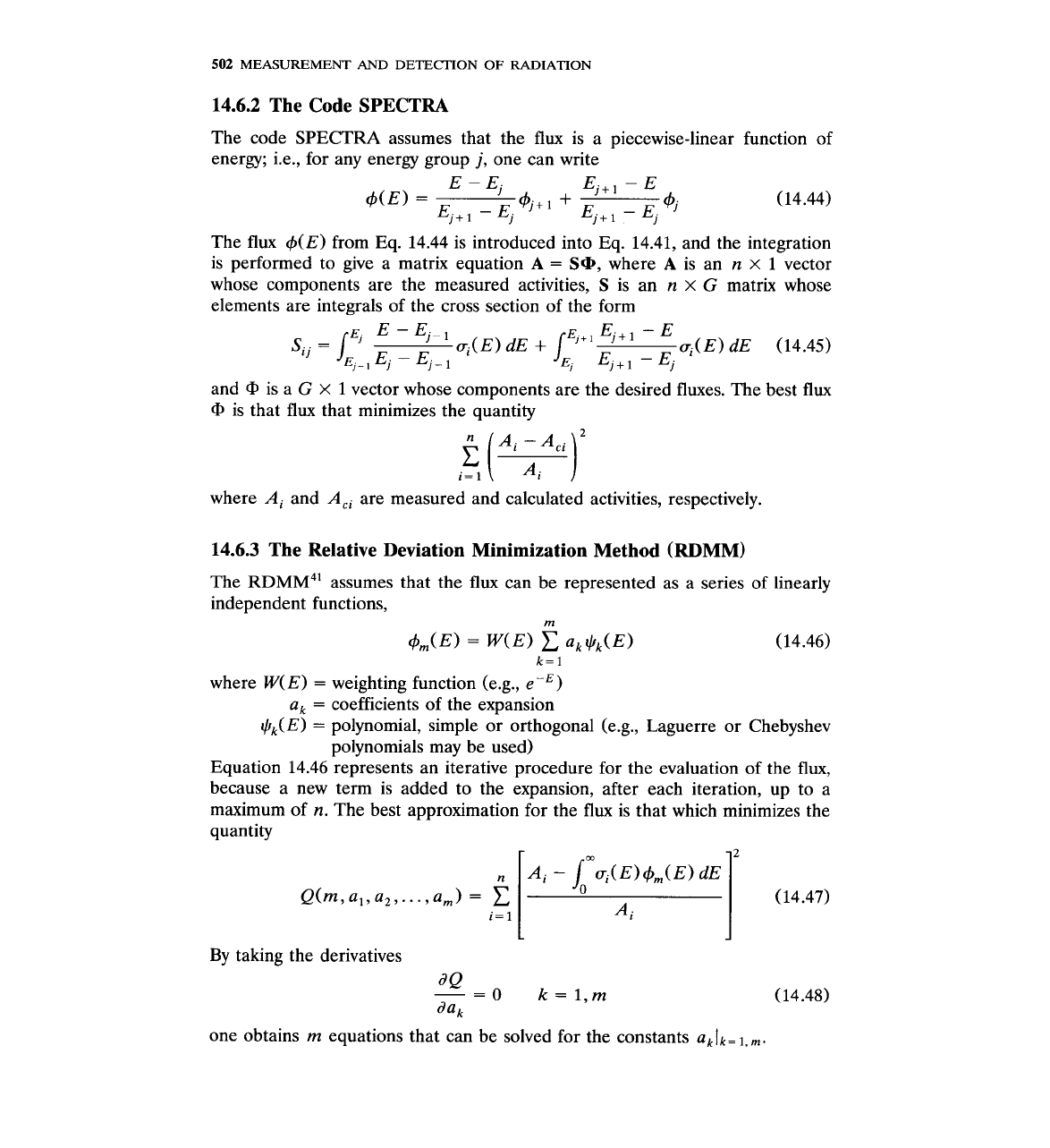
502
MEASUREMENT
AND
DETECTION
OF
RADIATION
14.6.2 The Code
SPECTRA
The code SPECTRA assumes that the flux is a piecewise-linear function of
energy; i.e., for any energy group
j,
one can write
The flux +(E) from Eq. 14.44 is introduced into Eq. 14.41, and the integration
is performed to give a matrix equation
A
=
SQ,
where
A
is an
n
x
1
vector
whose components are the measured activities,
S
is an
n
x
G
matrix whose
elements are integrals of the cross section of the form
and
Q,
is a
G
X
1
vector whose components are the desired fluxes. The best flux
Q,
is that flux that minimizes the quantity
where
A,
and
A,,
are measured and calculated activities, respectively.
14.6.3 The Relative Deviation Minimization Method (RDMM)
The RDMM4' assumes that the flux can be represented as a series of linearly
independent functions,
m
4,(E)
=
W(E) ak$k,,(E) (14.46)
k=
1
where W( E)
=
weighting function (e.g.,
e-E)
a,
=
coefficients of the expansion
ICI,(E)
=
polynomial, simple or orthogonal (e.g., Laguerre or Chebyshev
polynomials may be used)
Equation 14.46 represents an iterative procedure for the evaluation of the flux,
because a new term is added to the expansion, after each iteration, up to a
maximum of
n.
The best approximation for the flux is that which minimizes the
quantity
By
taking the derivatives
one obtains
rn
equations that can be solved for the constants aklk=
',,.
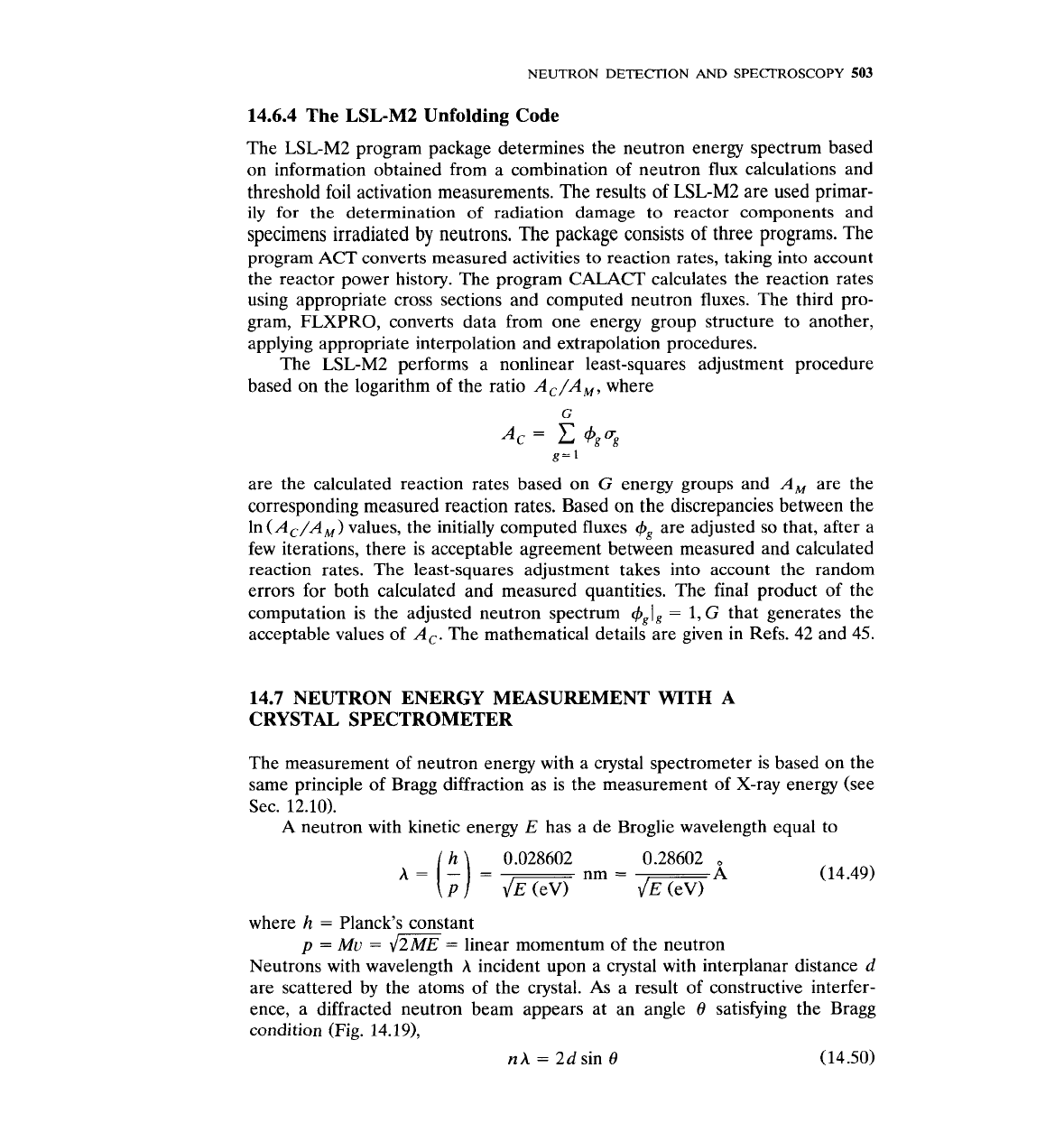
NEUTRON
DETECTION
AND
SPECTROSCOPY
503
14.6.4 The LSL-M2 Unfolding Code
The LSL-M2 program package determines the neutron energy spectrum based
on information obtained from a combination of neutron flux calculations and
threshold foil activation measurements. The results of
LSL-M2
are used primar-
ily
for the
determination of radiation damage to reactor components and
specimens irradiated
by
neutrons. The package consists of three programs. The
program ACT converts measured activities to reaction rates, taking into account
the reactor power history. The program CALACT calculates the reaction rates
using appropriate cross sections and computed neutron fluxes. The third pro-
gram, FLXPRO, converts data from one energy group structure to another,
applying appropriate interpolation and extrapolation procedures.
The LSL-M2 performs a nonlinear least-squares adjustment procedure
based on the logarithm of the ratio
Ac/AM, where
G
A,
=
C
4yg
g=
1
are the calculated reaction rates based on
G
energy groups and
A,
are the
corresponding measured reaction rates. Based on the discrepancies between the
In (Ac/AM) values, the initially computed fluxes
+g
are adjusted so that, after a
few iterations, there is acceptable agreement between measured and calculated
reaction rates. The least-squares adjustment takes into account the random
errors for both calculated and measured quantities. The final product of the
computation is the adjusted neutron spectrum
+gI,
=
1,
G
that generates the
acceptable values of A,. The mathematical details are given in Refs. 42 and 45.
14.7 NEUTRON ENERGY MEASUREMENT WITH A
CRYSTAL SPECTROMETER
The measurement of neutron energy with a crystal spectrometer is based on the
same principle of Bragg diffraction as is the measurement of X-ray energy (see
Sec. 12.10).
A neutron with kinetic energy
E
has a de Broglie wavelength equal to
where
h
=
Planck's constant
p
=
Mu
=
d?%@
=
linear momentum of the neutron
Neutrons with wavelength
A
incident upon a crystal with interplanar distance d
are scattered by the atoms of the crystal.
As
a result of constructive interfer-
ence, a diffracted neutron beam appears at an angle 0 satisfying the Bragg
condition (Fig.
14.19),
nA= 2dsinO (14.50)
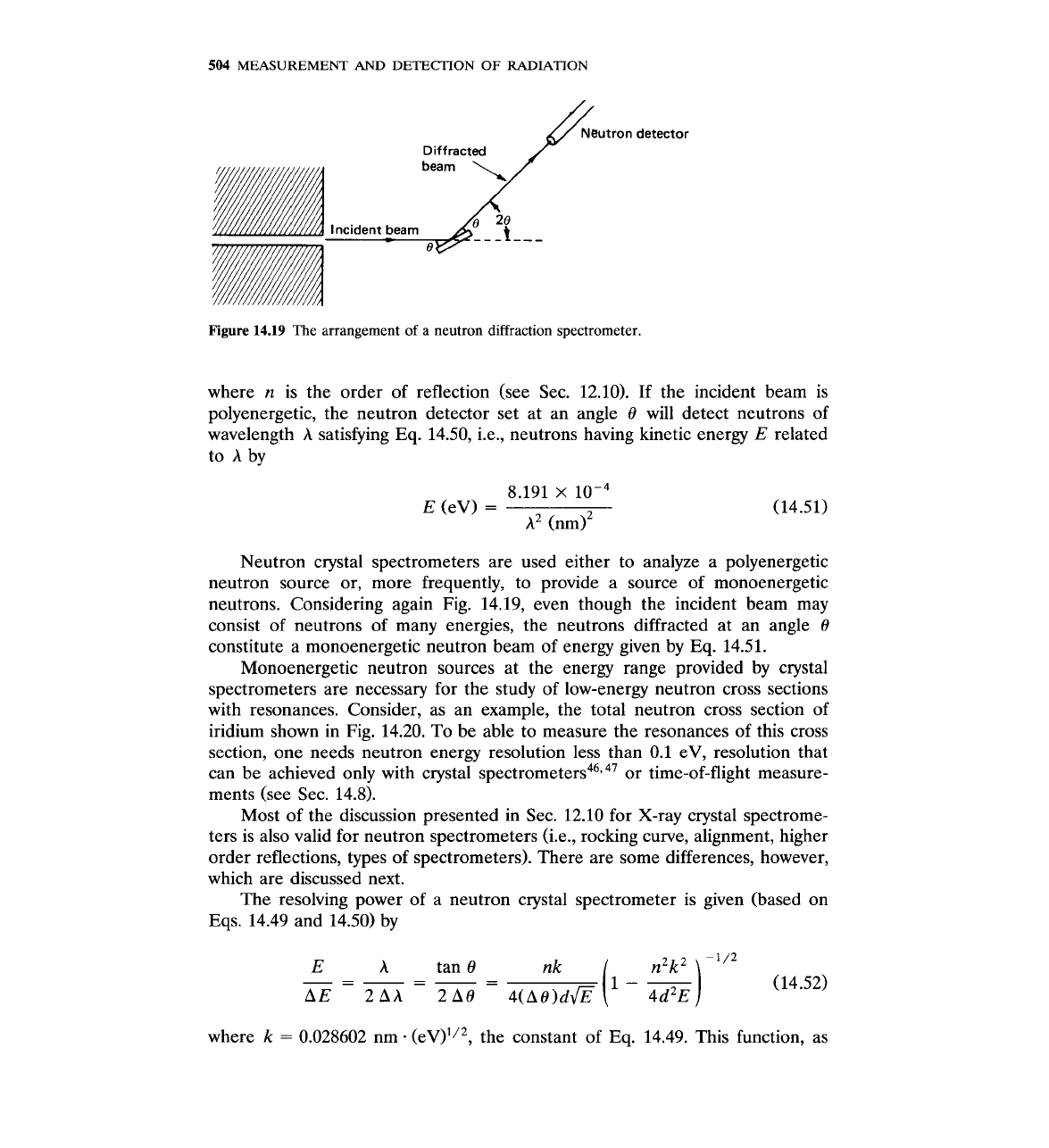
504
MEASUREMENT
AND
DETECTION
OF
RADIATION
Diffracted
Figure
14.19
The arrangement of
a
neutron diffraction spectrometer.
where n is the order of reflection (see Sec. 12.10). If the incident beam is
polyenergetic, the neutron detector set at an angle
8
will detect neutrons of
wavelength
A
satisfying Eq. 14.50, i.e., neutrons having kinetic energy
E
related
to h by
Neutron crystal spectrometers are used either to analyze a polyenergetic
neutron source or, more frequently, to provide a source of monoenergetic
neutrons. Considering again Fig. 14.19, even though the incident beam may
consist of neutrons of many energies, the neutrons diffracted at an angle
8
constitute a monoenergetic neutron beam of energy given by Eq. 14.51.
Monoenergetic neutron sources at the energy range provided by crystal
spectrometers are necessary for the study of low-energy neutron cross sections
with resonances. Consider, as an example, the total neutron cross section of
iridium shown in Fig. 14.20. To be able to measure the resonances of this cross
section, one needs neutron energy resolution less than 0.1
eV, resolution that
can be achieved only with crystal
spectrometer^^^,^^
or time-of-flight measure-
ments (see Sec. 14.8).
Most of the discussion presented in Sec. 12.10 for X-ray crystal spectrome-
ters is also valid for neutron spectrometers (i.e., rocking curve, alignment, higher
order reflections, types of spectrometers). There are some differences, however,
which are discussed next.
The resolving power of a neutron crystal spectrometer is given (based on
Eqs. 14.49 and 14.50) by
E
A
n2k2
1/2
-
-
tan
8
nk
-
(l
-
qd2E)
(14.52)
AE 2Ah 2AO 4(~0)d@
where k
=
0.028602 nm
.
(ev)'I2, the constant of
Eq.
14.49. This function, as
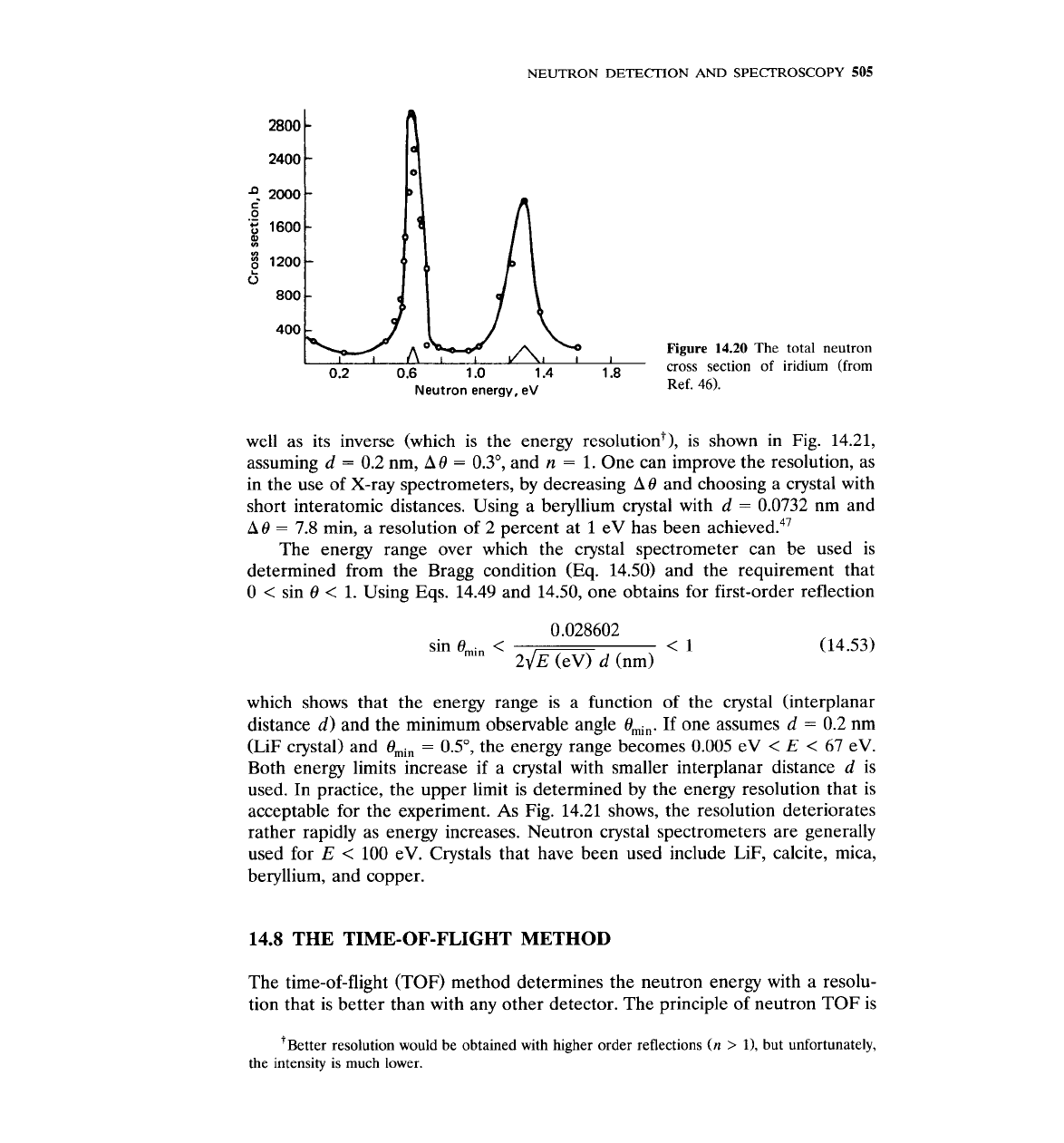
NEUTRON
DETECTION
AND
SPECTROSCOPY
505
Neutron energy, eV
Figure
14.20
The total neutron
cross section of iridium (from
Ref.
46).
well as its inverse (which is the energy resolutiont), is shown in Fig. 14.21,
assuming
d
=
0.2 nm,
A0
=
0.3", and
n
=
1. One can improve the resolution, as
in the use of X-ray spectrometers, by decreasing
A0
and choosing a crystal with
short interatomic distances. Using a beryllium crystal with
d
=
0.0732 nm and
A0
=
7.8 min, a resolution of 2 percent at
1
eV has been achieved.47
The energy range over which the crystal spectrometer can be used is
determined from the Bragg condition (Eq. 14.50) and the requirement that
0
<
sin
0
<
1.
Using Eqs. 14.49 and 14.50, one obtains for first-order reflection
0.028602
sin
Omin
< <
1
2~~
d
(nm)
which shows that the energy range is a function of the crystal (interplanar
distance
d)
and the minimum observable angle
Omin.
If one assumes
d
=
0.2 nm
(LiF crystal) and
Omin
=
OSO, the energy range becomes 0.005 eV
<
E
<
67 eV.
Both energy limits increase if a crystal with smaller interplanar distance
d
is
used. In practice, the upper limit is determined by the energy resolution that is
acceptable for the experiment. As Fig. 14.21 shows, the resolution deteriorates
rather rapidly as energy increases. Neutron crystal spectrometers are generally
used for
E
<
100 eV. Crystals that have been used include LiF, calcite, mica,
beryllium, and copper.
14.8
THE TIME-OF-FLIGHT METHOD
The time-of-flight (TOF) method determines the neutron energy with a resolu-
tion that is better than with any other detector. The principle of neutron TOF is
'~etter resolution would be obtained with higher order reflections
(n
>
I),
but unfortunately,
the intensity is much lower.
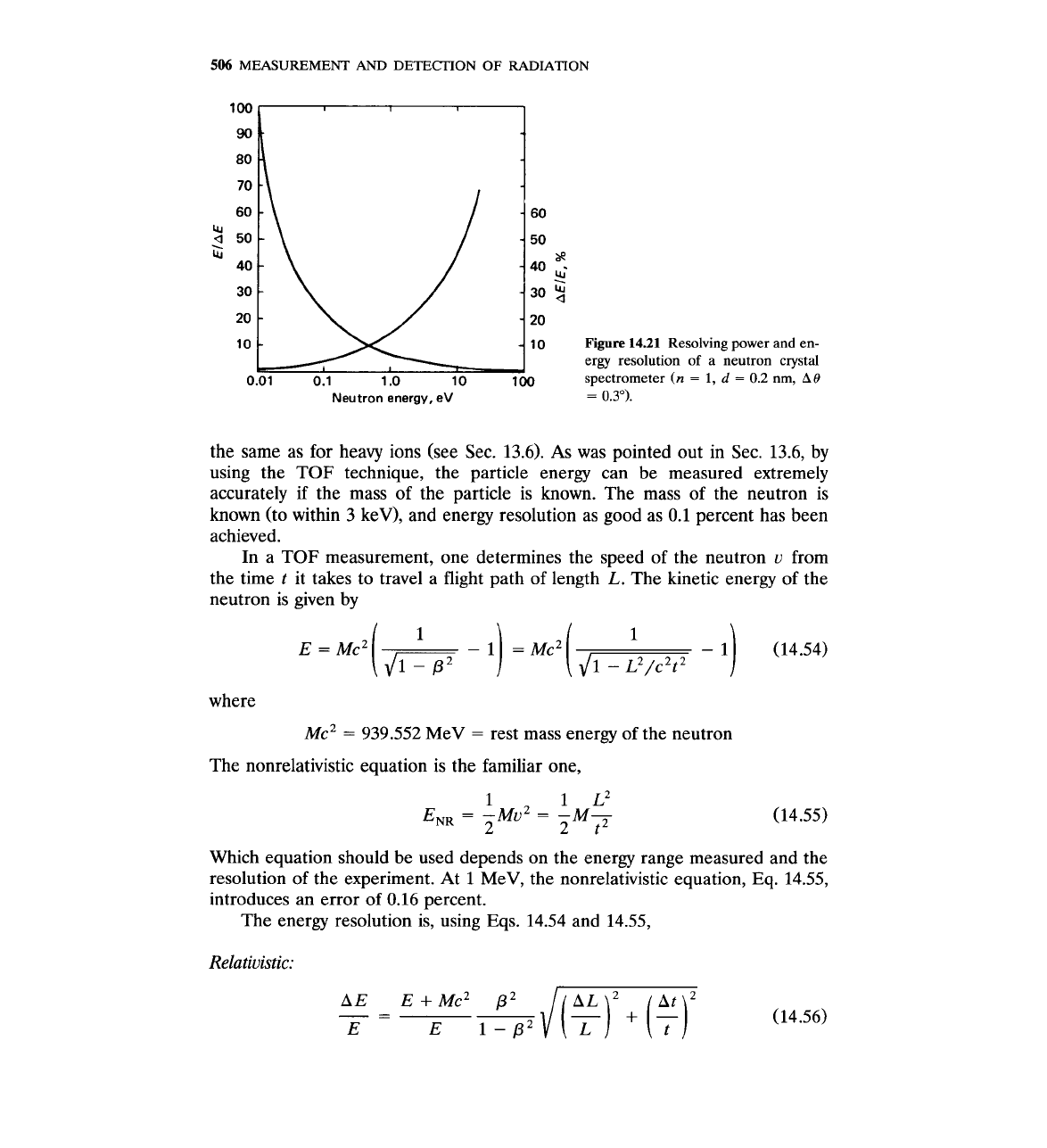
506
MEASUREMENT
AND
DETECTION
OF
RADIATION
Figure
14.21
Resolving power and en-
ergy resolution of a neutron crystal
spectrometer
(n
=
1,
d
=
0.2
nm,
A0
Neutron energy, eV
=
0.3").
the same as for heavy ions (see Sec.
13.6).
As was pointed out in Sec.
13.6,
by
using the TOF technique, the particle energy can be measured extremely
accurately if the mass of the particle is known. The mass of the neutron is
known (to within
3
keV), and energy resolution as good as 0.1 percent has been
achieved.
In a TOF measurement, one determines the speed of the neutron
u
from
the time
t
it takes to travel a flight path of length
L.
The kinetic energy of the
neutron is given by
where
MC'
=
939.552 MeV
=
rest mass energy of the neutron
The nonrelativistic equation is the familiar one,
Which equation should be used depends on the energy range measured and the
resolution of the experiment. At
1
MeV, the nonrelativistic equation, Eq. 14.55,
introduces an error of 0.16 percent.
The energy resolution is, using Eqs. 14.54 and 14.55,
Relativistic:

NEUTRON
DETECIION
AND
SPECTROSCOPY
507
Nonrelativistic:
In neutron
TOF
experiments, the neutron source is
a
burst of neutrons gener-
ated either by a velocity selector (chopper) or by an ion beam, as explained later
in this section. The time-of-flight
t
is the difference between the time of
production of the neutron burst and the time of neutron detection.
The uncertainty At consists of three parts.
1.
At, is the uncertainty in the time of neutron emission; it is essentially equal
to the width of the neutron burst and ranges from a few hundred nanosec-
onds to less than a hundred picoseconds.
2.
At, is the uncertainty in the time of neutron detection; it depends on the
pulse risetime, since it is the pulse risetime that signals the time of detection.
Neutron detectors used today have a pulse risetime equal to 5 ns or less.48
3.
At, is the uncertainty in neutron slowing-down time if the source is sur-
rounded by a moderator.
The uncertainty AL is due to the finite thicknesses of the neutron-produc-
ing target and the neutron detector. The uncertainty in the measurement
of
L
itself can be made negligible. The longer the flight path is, the smaller the
uncertainty AL/L becomes.
As
the length L increases, however, the intensity
of the source should increase, and by a greater factor, so that the counting rate
in the detector stays the same.
It is customary to use the quantity t/L as a figure
of
merit for TOF
experiments. From Eqs. 14.54 and 14.55, one obtains
Table 14.5 gives typical t/L values.
The requirements for slow-neutron TOF experiments fall in the
ps/m
range, and those of fast neutrons in the ns/m range. Because of this large
difference in timing requirements, it is impossible to span the whole neutron
energy range (eV to MeV) with the same TOF spectrometer.
The change of resolution with neutron energy is the same for TOF and
crystal spectrometers. In both systems, the energy spread AE changes, essen-
